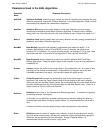
960L Owner’s Maunal Using The Reverb Program
level; this simulates a very diffused reflection off the
back wall of the hall, helping to create a sense of size
and space. This reflection becomes stronger and
stronger, reaching optimal loudness when Shape is at
about 2/3 of its range. The highest Shape settings are
typically used for effects. Near the top of the scale, the
rear hall energy buildup becomes stronger than the
earlier part of the envelope, an effect used to create an
inverse sound (see Reverse).
To avoid colorations, the signal is randomized by the
Spin and Wander parameters. The randomizers
controlled by the Spin and Wander parameters
principally affect the perceived acoustics of the space.
High settings can be used to break up small-room
modes, as when recording a voice-over in an announce
booth, but extreme settings can have pitch effects.
Surround Hall
Surround Hall is a surround version of Random Hall
having 16 delay voices, one for each possible channel
pairing (LF to C, C to LF, LF to LS, etc.). It may be
useful for Foley work by giving a more precise sense of
a space’s size.
Chamber
Chamber is a complex miniature-space effect
resembling an echo chamber at its smaller settings and,
at its larger ones, a small performance space with a
more rapid build-up of reflection density than Random
Hall. Reverberant tails are randomized.
Plate & Surround Plate
The Plate programs mimic the sounds of metal plates,
with high initial diffusion and a relatively bright, colored
sound. For this reason, they are good choices for
percussion. They are designed to be heard as part of
the music, mellowing and thickening the initial sound
itself. The Plate sound is what most people associate
with the word reverb, and it is useful for all popular
music.
Ambience & Surround Ambience
Ambience generates the strong reflections that appear
in the first few hundred milliseconds of the reverberation
process. These early reflections become part of the
direct sound without coloring it, giving it better blend
and a definite position in space and conveying the
impression of a hall surrounding you while the music is
playing. It lends warmth, spaciousness and depth to a
performance.
When a signal is supplied to a single input of Surround
Ambience – for example the left front – the program
generates early reflections first in the front left and right
output channels. If the FSLevel control is set to
maximum, reflections are then generated in the left rear
and right rear output channels. FSLevel and FSRolloff
control the relative level and frequency response
between the front early reflections and rear early
reflections. In a large room the rear early reflections
could be perhaps 3dB less in total level, and somewhat
more rolled-off in frequency response. (However, it is
unlikely that these differences are audible in practice.)
When a signal is supplied to a rear input, for example
the the Left Surround input, the primary early
reflections will come from the left surround and right
surround outputs, and FSLevel and FSRolloff control
the level and frequency response of the early
reflections that come from the front. Thus with surround
ambience the amplitude and frequency characteristics
of a large room can be generated.
The Ambience algorithm is very useful for adding a
room sound to recorded music or speech, making it
easy to match a studio recording of dialog to a typical
room environment. At delay settings of roughly 100 to
500 milliseconds, it can be used to simulate the
ambience of very small rooms without the colorations
often found in actual spaces of that size. When set to
deal with the first 50 msec of the signal, the range
perceived as being part of the initial phone, it can be
used to realistically add distance to a close-miked
signal without diminishing clarity. If an ensemble has
been recorded with close miking and pan pots,
Ambience can provide the missing blend and depth,
increasing apparent distance while preserving the
apparent positions of the instruments. It is also useful
in matching a closely miked accent microphone to the
overall ambience of the recording; this allows a soloist’s
level to be increased without changing the apparent
distance.
The Ambience algorithm does not include extensive
provisions for modifying the characteristics of the late
reverberation; the Shape, Spread, and Bass
characteristics are fixed. However the apparent size of
the late reverberation is adjustable with the size control.
High settings of the Size control can be very effective at
generating the sound of a large space with high clarity.
The lack of the BassMult control can be compensated
by adding a low frequency shelving boost of 2 to 6dB
below 200Hz to the reverberation sends or returns.
This type of boost is often very useful when working
with music that includes both vocals and instruments.
Algorithms, Continued
5-7


















